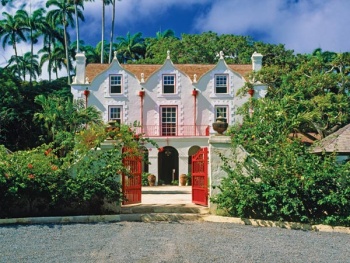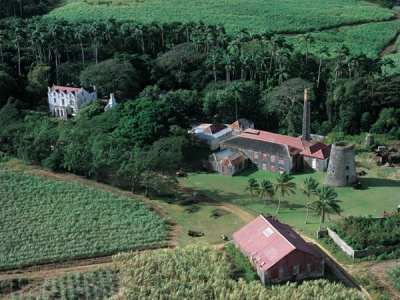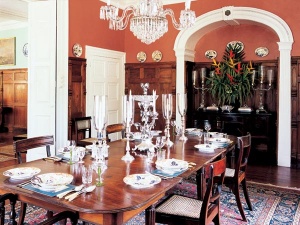St. Nicholas Abbey  St. Nicholas Abbey is not a religious abbey but one of a few surviving Jacobean-style houses in the Western Hemisphere. It
is said that St Nicholas Abbey was built by Lieutenant Colonel Benjamin
Berringer in 1650 and went into sugar production. He came to Barbados
around 1624 from Iver, Buckinghamshire, England and is thought to be
one of the early sugar planters. The story goes that to this day, Colonel Benjamin Berringer supposedly still haunts St Nicholas Abbey. Sir
John Yeamans, Berringer's neighbour, friend and business partner,
'acquired' the plantation after Berringer died. Its believed that the
two men competed for the affections of Berringer's wife so Yeamans
arranged to have Berringer poisoned, and thus he became the sole owner
of St Nicholas Abbey as well as taking the widowed Mrs Berringer for
his wife in 1661 and renamed the Plantation 'Yeamans' Plantation. When
Susan Berringer, Lieutenant Colonel Benjamin Berringer's granddaughter
became the owner of St Nicholas, which she inherited through her father
John Berringer who outlived his mother by one month, she was already
married to George Nicholas whom, as her husband and by law,
automatically became the owner of the plantation. The name of the
plantation was then changed from Yeamans Plantation to Nicholas
Plantation in honour of Susan's husband. Susan was determined
that she would not keep the name of the person who murdered her
grandfather. The Nicholas' lived at St Nicholas Abbey until the 1720's
when it became impossible for them to operate the plantation, as a
result of sugar prices falling. Eventually they were forced to sell. | St
Nicholas Abbey was purchased by the Dottin family in the 1720's. A
prominent family in Barbados, they owned several plantations. Joseph
Dottin, Deputy Governor of Barbados, lived with his wife Ann Dottin and
family in Black Rock. It was the custom for Joseph Dottin, to present
each of his several daughters with a plantation as a wedding gift. And
thus, St Nicholas Abbey was again passed by marriage, as a wedding
present, to the Alleynes through the union of Christian Dottin and John
Gay Alleyne on October 19, 1746. |  | Sir
John Alleyne, as he later became, was a very close friend of John
Sober. John Sober inherited Mount Gilboa Plantation/Distillery from his
father William Sandiford in 1747, and upon doing so he appointed Sir
John Gay Alleyne as the manager. Sir John did such a good job at
managing the plantation that it was renamed Mount Gay in his honour
after his passing in 1801. Mahogany trees were introduced into
Barbados after the Treaty of Paris in 1763 and Sir John is said to have
been instrumental in the planting of the avenue of mahogany trees
leading up the famous Cherry Tree Hill which was originally lined with
cherry trees (hence the name). Cherry Tree Hill, part of the St
Nicholas Abbey estate - another tourist favourite - approximately 850
feet above sea level, presents one with a most breath taking view of
the Scotland District which basically covers the parish of St Andrew. Sir
John Alleyne, born in 1724, lived at St. Nicholas, was also the Speaker
of the House of Assembly and a very prominent man in Barbados. He held
this office between 1767 and 1797. He was created 1st Baronet Alleyne,
of Four Hills, in St Thomas on 6 April 1769. Sir John was also a keen
supporter of the abolition of slavery in Barbados. When Sir
John died in December 1801, the estate reverted to the Dottin family,
but unfortunately, it took some time in locating any of the remaining
family members as they were all scattered abroad and during this time
the plantation had racked up a considerable amount of debt, over
£20,500, so it was subsequently taken over by the Chancery Court of
Bridgetown in 1811. Laurence Trent Cumberbatch and Edward
Cumberbatch Snr, brothers, purchased the plantation through the
courts. The Cumberbatch brothers had agreed that the property would
not be passed to Edward Cumberbatch Jnr if he married Mary Gertrude
Ashe, a musician's daughter from Bath because she had nothing to bring
to the marriage in support of the lifestyle they would wish once in
possession of such wealth. Edward Jnr was a spendthrift and the
brothers did not think him capable of managing the plantation and at
worst they felt he would lose the property. They decided to
leave St Nicholas Abbey, nearby Ebworth Plantation, as well as two
other houses in Speightstown, where they kept their mistresses, to
Edward Jnr's sister Sarah. Sarah was by this time married to Charles
Cave, a banker of London from a very wealthy family. Charles was seen
as 'a bit of a miser' and they felt confident the plantation would be
well taken care of, and of course he would look after Edward Jnr and
his wife as well. And so it was, St Nicholas was passed to the Caves, once again by marriage.
Though
Charles Cave and Susan Cumberbatch had already been married since May
1818, the Cumberbatch Brother's wealth was only passed on to Charles
Cave in 1834 after the passing of Laurence Trent Cumberbatch in 1833.
It is believed that this is when they renamed the plantation St
Nicholas Abbey. It seems they put the names 'Nicholas Plantation', 'St
Nicholas Parish', where the Cumberbatch family lived in Bristol,
England and 'Bath Abbey,' in England where they were married, together
and called the plantation house St Nicholas Abbey. The property
was then passed to Laurence Trent Cave when Charles Cave died in 1887.
Laurence Cave's Regiment, 'Dorsetshire' was sent to Barbados and Saint
Lucia around 1850, he visited St Nicholas Abbey where he painted a
watercolour of the house. Laurence was married twice. His first wife
was Emily Rossiler Holme, whom he married in1851 and his second wife
was Lucy Greenwood whom he in 1860 in Knightsbridge, London. He died in
1899. St Nicholas Abbey then passed to Charles John Phillip
Cave who, though he never worked a day in his life, was never idle for
a moment.In 1939, after the Second World War, Charles John Phillip Cave
sold Ebworth Plantation and the two houses in Speightstown for around
5,000 pounds and gave the money to Hugh Cave to purchase a plantation
in New Zealand where he settled. Laurence Charles Henry Cave
took over St Nicholas Abbey from his father and he in turn passed it
over to his son Stephen Francis Cave. The Caves continued the
production of sugar and syrup at the plantation's mill, firstly powered
by the windmill and, then switching to the use of steam engines. This
method of production ceased in 1947 and St Nicholas' cane crops have
since been processed elsewhere on the island. However, the sugar mill
and bases of two windmills still exist today. The plantation currently
produces 200 acres in cane annually through the Barbados Agricultural
Management Corporation (BAMC) Lieutenant Colonel Stephen Cave,
great, great grandson of Charles Cave, and eldest son of Laurence
Charles Henry Cave, inherited St Nicholas Abbey in 1964. He was
delighted to share the history of the plantation. He showed visitors a
series of home movie films of life on the estate in the 1930's. These
he discovered upon inheritance of the estate. Col Cave lived on the
plantation from 1978 until his passing on November 1, 2003, at which
time James Joseph Petri, his nephew, inherited St Nicholas Abbey. The
Plantation was passed to James Joseph Petri, youngest of two sons born
to Susan Mary Dorothy Petri (nee Cave, oldest child of Lawrence Charles
Henry Cave) and Arthur David Petri. Lieutenant Colonel Cave felt that
because Arthur Charles David was married with three children, it would
be difficult for him to run the Plantation from England and so the
decision was made to pass ownership on to James, his younger brother,
who, being single would be better equipped to manage and maintain the
Plantation. St Nicholas Abbey was then sold to Larry and Anna
Warren early 2006. They have restored the house and its steam-drive and
bottles rum and other sugar cane products. You can tour the Abbey - visit the St. Nicholas Abbey website.  | 
